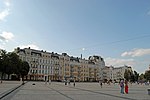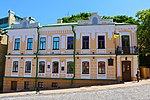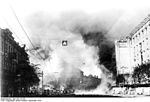Church of the Tithes

The Church of the Tithes or Church of the Dormition of the Virgin (Ukrainian: Десятинна Церква, Desiatynna Tserkva) was the first stone church in Kyiv. Originally it was built by the order of Grand Prince Volodymyr (Volodymyr) the Great between 989 and 996 by Byzantine and local workers at the site of death of martyrs Theodor the Varangian and his son Johann. It was originally named the "Church of Our Lady", in honor of the Dormition of the Theotokos. The church was ruined in 1240 during the siege of Kyiv by Mongol armies of Batu Khan. Volodymyr set aside a tithe of his income and property to finance the church's construction and maintenance, which gave the church its popular name. On an initiative of the Metropolitan of Kyiv Eugene Bolkhovitinov, the church was rebuilt in the mid-19th century, but in 1928 it was once again destroyed by the Soviet regime.
Excerpt from the Wikipedia article Church of the Tithes (License: CC BY-SA 3.0, Authors, Images).Church of the Tithes
Volodymyrska Street, Kyiv Центр
Geographical coordinates (GPS) Address Nearby Places Show on map
Geographical coordinates (GPS)
| Latitude | Longitude |
|---|---|
| N 50.4577777878 ° | E 30.51750001 ° |
Address
Десятинна церква
Volodymyrska Street
01025 Kyiv, Центр
Ukraine
Open on Google Maps











